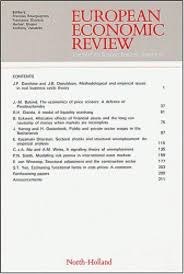
Poledna, S., Miess, M., Hommes, C. and Rabitsch, K. (2023). Economic forecasting with an agent-based model European Economic Review, 151:.
-
Affiliated author
-
Publication year2023
-
JournalEuropean Economic Review
We develop the first agent-based model (ABM) that can compete with benchmark VAR and DSGE models in out-of-sample forecasting of macro variables. Our ABM for a small open economy uses micro and macro data from national accounts, sector accounts, input–output tables, government statistics, and census and business demography data. The model incorporates all economic activities as classified by the European System of Accounts (ESA 2010) and includes all economic sectors populated with millions of heterogeneous agents. In addition to being a competitive model framework for forecasts of aggregate variables, the detailed structure of the ABM allows for a breakdown into sector-level forecasts. Using this detailed structure, we demonstrate the ABM by forecasting the medium-run macroeconomic effects of lockdown measures taken in Austria to combat the COVID-19 pandemic. Potential applications of the model include stress-testing and predicting the effects of monetary or fiscal macroeconomic policies.